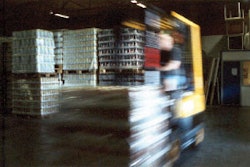Even as implementations continue apace, adoption challenges remain and companies still struggle to find ROI in radio frequency identification
Natick, MA — February 22, 2006 — Implementations of radio frequency identification technologies are continuing apace in the pharmaceutical industry, but many challenges remain to widespread adoption, and RFID will not be the "silver bullet" that can slay all supply chain problems, according to a recent report from Venture Development Corporation.
In the new Pharmaceutical Supply Chain Vertical Market volume of its annual RFID Business Planning Service, VDC estimates that the global market for RFID systems in the pharmaceutical vertical reached an estimated $9.3 million in 2005, with hardware accounting for approximately 42 percent, or about $4.4 million.
In addition, VDC anticipates a compounded annual growth rate (CAGR) of nearly 118 percent over the next three years, with revenue shipments exceeding $96 million in 2008. Hardware will account for about $48.7 million, while services will bring in $48.1 million, in VDC's estimation.
With the Wal-Mart and U.S. Department of Defense mandates, pharmaceutical suppliers are required to tag a subset of the pallets and cases shipped to select distribution centers. However, most pharmaceutical manufacturers and distributors struggle with determining how RFID technology can benefit their operations and provide an internal return on investment (ROI).
In fact, the potential benefits from RFID vary greatly among supply chain operations, VDC notes. Among RFID's core value propositions are increased operational efficiency, real-time visibility, reduced labor costs and enhanced security. However, RFID implementations are unique to each user and application environment. As a result, pharmaceutical manufacturers and distributors are increasingly turning to solutions providers and systems integrators for assistance with determining their specific business case for RFID and resolving key end-user adoption and integration challenges, including:
While wide-scale deployments are limited today, the increasing number of pilots and small-scale rollouts suggest users are becoming more aggressive with RFID adoption. According Michael J. Liard, director of VDC's RFID Practice, "Even if the true benefits will not be realized for several years, establishing the base RFID infrastructure today is critical for future supply chain integration."
Additional Articles of Interest
— As market conditions continue to change, manufacturers are looking for any extra advantage against their competitors. Could a manufacturing execution system be the solution? Read more in "Extending Supply Chain Execution in Production to Improve Fulfillment," an SDCExec.com exclusive.
— Got reverse logistics? Learn how one company's high-velocity "reverse logistics" operation put its ERP system to the test by making pre-owned network equipment available globally. Read more in the SDCExec.com exclusive "5 Principles for a Better Reverse Logistics Operation."
Natick, MA — February 22, 2006 — Implementations of radio frequency identification technologies are continuing apace in the pharmaceutical industry, but many challenges remain to widespread adoption, and RFID will not be the "silver bullet" that can slay all supply chain problems, according to a recent report from Venture Development Corporation.
In the new Pharmaceutical Supply Chain Vertical Market volume of its annual RFID Business Planning Service, VDC estimates that the global market for RFID systems in the pharmaceutical vertical reached an estimated $9.3 million in 2005, with hardware accounting for approximately 42 percent, or about $4.4 million.
In addition, VDC anticipates a compounded annual growth rate (CAGR) of nearly 118 percent over the next three years, with revenue shipments exceeding $96 million in 2008. Hardware will account for about $48.7 million, while services will bring in $48.1 million, in VDC's estimation.
With the Wal-Mart and U.S. Department of Defense mandates, pharmaceutical suppliers are required to tag a subset of the pallets and cases shipped to select distribution centers. However, most pharmaceutical manufacturers and distributors struggle with determining how RFID technology can benefit their operations and provide an internal return on investment (ROI).
In fact, the potential benefits from RFID vary greatly among supply chain operations, VDC notes. Among RFID's core value propositions are increased operational efficiency, real-time visibility, reduced labor costs and enhanced security. However, RFID implementations are unique to each user and application environment. As a result, pharmaceutical manufacturers and distributors are increasingly turning to solutions providers and systems integrators for assistance with determining their specific business case for RFID and resolving key end-user adoption and integration challenges, including:
- Evaluating whether RFID will solely be used for outbound compliance or if it will become a part of the overall enterprise operation;
- Determining the RFID "friendliness" of their products — for example, evaluating performance in the presence or water, metal, RF interference, etc.; transponder form factor design; and tagged object properties (i.e., packaging materials, contents, etc.);
- Identifying at which points in the manufacturing and distribution flow tags should be applied (and read);
- Selecting the best physical location for the tag on the pallet, case, and/or item (placement and orientation);
- Deciding how the RFID system should interface with existing host systems such as automatic identification and data collection (AIDC), enterprise resource planning (ERP) and supply chain execution (SCE) systems;
- Selecting the best technology and partner(s) based on specific application requirements; and,
- Managing and leveraging the influx of real-time RFID data effectively to improve business processes.
While wide-scale deployments are limited today, the increasing number of pilots and small-scale rollouts suggest users are becoming more aggressive with RFID adoption. According Michael J. Liard, director of VDC's RFID Practice, "Even if the true benefits will not be realized for several years, establishing the base RFID infrastructure today is critical for future supply chain integration."
Additional Articles of Interest
— As market conditions continue to change, manufacturers are looking for any extra advantage against their competitors. Could a manufacturing execution system be the solution? Read more in "Extending Supply Chain Execution in Production to Improve Fulfillment," an SDCExec.com exclusive.
— Got reverse logistics? Learn how one company's high-velocity "reverse logistics" operation put its ERP system to the test by making pre-owned network equipment available globally. Read more in the SDCExec.com exclusive "5 Principles for a Better Reverse Logistics Operation."
- More research from VDC.










